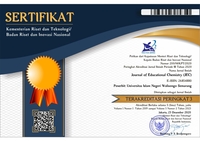The Analysis of HOTS (Higher Order Thinking Skills) Questions Based on Brookhart Category in the 2013 Curriculum High School Chemistry Textbook
DOI:
https://doi.org/10.21580/jec.2021.3.1.6546Keywords:
chemistry textbooks, higher order thinking skills, HOTS, questionAbstract
Higher Order Thinking Skills is one of the skills necessary in 21st century. So, learning media are required to improve students’ higher order thinking skills. Chemistry textbooks which are used as learning media should contain questions that improve students' thinking processes, especially higher order thinking skills (HOTS). However, there are no criteria for assessing the questions in the textbook, especially for higher order thinking questions. This study aims to determine the HOTS aspect using the Brookhart category on questions contained in the XII grade chemistry textbook. The research method used is descriptive method of document analysis. The results showed that the average percentage of HOTS questions in the three class XII chemistry textbooks was 25.95%, covering aspects of analyzing 8.85%, creating 3.51%, reasoning and logic 8.35%, problem solving 3.71%, and creative thinking 1.53%. Meanwhile, the aspects of evaluating and making decisions are not present in each analyzed chemistry textbook. Based on the research results, it can be seen that the chemistry textbook for class XII is still dominated by questions of low-level thinking skills.
Downloads
References
Abdelrahman, M. S. B. (2014). An Analysis of the Tenth Grade English Language Textbooks Questions in Jordan Based on the Revised Edition of Bloom’s Taxonomy An Analysis of the Tenth Grade English Language Textbooks Questions in Jordan Based on the Revised Edition of Bloom’s Taxonomy. Journal of Education and Practice, 5(18), 139–151.
Abdullah, A., Albeta, S. W., & Ardiansyah, A. (2018). Profile Of Chemical Teacher Candidates’ Higher Order Thinking Skills (HOTS) on Ionic Equilibrium In Solution Topic. Unnes Science Education Journal, 7(3), 300–305.
Afifah, I. R. N., & Retnawati, H. (2019). Is it Difficult to Teach Higher Order Thinking Skills ? Journal of Physics: Conference Series, 1–7.
Anderson, L. W., & Krathwohl, D. R. (2001). A Taxonomy For Learning, Teaching, and Assessing: A Revision Of Bloom’s Taxonomy Of Educational Objectives. London: Pearson Education.
Ayuningrum, D. (2017). Strategi Pemecahan Masalah Matematika Siswa SMP ditinjau dari Tingkat Berpikir Geometri Van Hiele. KREANO Jurnal Matematika Kreatif-Inovatif, 8(1), 27–34.
Birgili, B. (2015). Creative and Critical Thinking Skills in Problem-based Learning Environments. Journal of Gifted Education and CreativityCreativity, 2(2), 71–80.
Brookhart, S. M. (2010). in Your Classroom. In How to Assess Higher-Order Thinking Skills in Your Classroom. USA: ASCD.
Ch, I. F., & Gusniarti, W. F. (2014). Profil Keterampilan Argumentasi Siswa Pada Konsep Koloid Yang Dikembangkan Melalui Pembelajaran Inkuiri Argumentatif. EDUSAINS, 6(01), 31–40.
Damanik, S. N. H., & Zainil, Y. (2019). The Analysis Of Reading Comprehension Questions In English Textbook By Using Higher Order Thinking Skill At Grade X Of SMAN 2 Padang. Journal of English Language Teaching, 8(1), 249–258.
Damayanti, I., Masykuri, M., & Yamtinah, S. (2019). Pengembangan Instrumen Penilaian Testlet Untuk Mengukur Kemampuan Berpikir Tingkat Tinggi Pada Materi Elektrokimia. INKUIRI: Jurnal Pendidikan IPA, 8(1), 59–71.
Haryani, S., Prasetya, A. T., & Saptarini. (2014). Identifikasi Materi Kimia SMA Sulit Menurut Pandangan Guru dan Calon Guru Kimia. Seminar Nasional Kimia Dan Pendidikan Kimia VI, 43–52.
Nofrion, N., & Wijayanto, B. (2018). Learning Activities in Higher Order Thinking Skill (Hots) Oriented Learning Context. Geosfera Indonesia, 3(2), 122–130.
Pratama, G. S., & Retnawati, H. (2018). Urgency of Higher Order Thinking Skills (HOTS) Content Analysis in Mathematics Textbook. Journal of Physics: Conference Series, 1097(1), 1–8.
Purba, M. (2016). Kimia untuk SMA/MA Kelas XII Kelompok Peminatan Matematika dan Ilmu-Ilmu Alam. Jakarta: Erlangga.
Rahmawati, G. (2015). Buku Teks Pelajaran Sebagai Sumber Belajar Siswa Di Perpustakaan Sekolah Di Sman 3 Bandung. Edulib, 5(1), 102–113.
Ramadhana, N. A., Rozimela, Y., & Fitrawati. (2018). High Order Thinking Skills-Based Questions In The Test Items Developed By Senior High School English Teachers Of Padang. Journal of English Language Teaching, 7(4), 720–731.
Rizqiana, F. A., Siddiq, M. & Rahmawati, A. (2019). Analisis Textbooks for High School Student Studying the Sciences Chemistry Materi Pokok Hidrokarbon dalam Perspektif Kurikulum 2013. Journal of Educational Chemistry (JEC), 1(1): 22-27.
Rochman, S., & Hartoyo, Z. (2018). Analisis High Order Thinking Skills (HOTS) Taksonomi Menganalisis Permasalahan Fisika. SPEJ (Science and Physics Education Journal), 1(2), 78–88.
Schleicher, A. (2019). PISA 2018: Insights and Interpretations. Paris: OECD Publishing.
Setyarini, S., & Ling, M. A. (2019). Promoting Higher Order Thinking Skills in Storytelling for Teaching English to Young Adolescents in 21st Century. International Seminar on Language, Education, and Culture, KnE Social Sciences, 2019, 155–164.
Sudarmo, U. 2013. Kimia untuk SMA/MA Kelas XII Kelompok Peminatan Matematika dan Ilmu Alam. Jakarta: Erlangga
Suprayitno, T. (2019). Pendidikan di Indonesia: belajar dari hasil PISA 2018. Jakarta: Badan Penelitian dan Pengembangan Kemendikbud.
Sutresna, N., Sholehudin, D. & Herlina, T. (2016). Buku Siswa Aktif dan Kreatif Belajar Kimia 3 untuk SMA/MA Kelas XII Peminatan Matematika dan Ilmu-Ilmu Alam. Bandung: Grafindo.
Upahi, J. E., & Jimoh, M. (2016). Classsification of End-of-Chapter Questions in Senior School Chemistry Textbooks used in Nigeria. European Journal of Science and Mathematics Education, 4(1), 90–102.
Zorluoglu, S. L., Kizilaslan, A., & Yapucuoglu, M. D. (2020). The analysis of 9th grade chemistry curriculum and textbook according to revised Bloom’s taxonomy. Cypriot Journal of Educational Sciences, 15(1), 9–20.
Downloads
Published
How to Cite
Issue
Section
License
The copyright of the received article shall be assigned to the journal as the publisher of the journal. The intended copyright includes the right to publish the article in various forms (including reprints). The journal maintains the publishing rights to the published articles.
Authors are permitted to disseminate published articles by sharing the link/DOI of the article at the journal. Authors are allowed to use their articles for any legal purposes deemed necessary without written permission from the journal with an acknowledgment of initial publication to this journal.

This work is licensed under a Creative Commons Attribution-NonCommercial-ShareAlike 4.0 International License.



